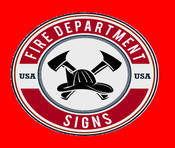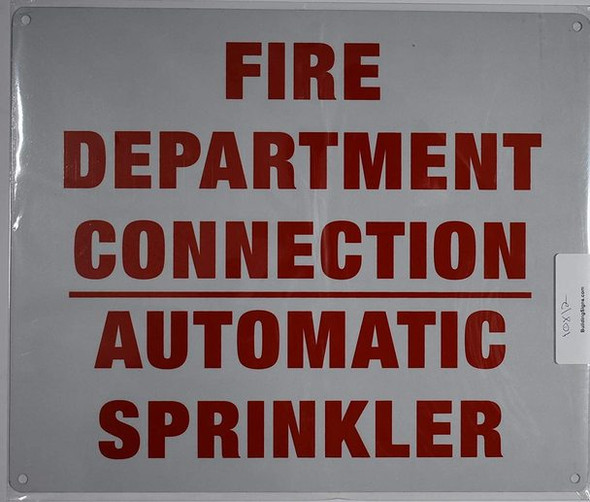BUILDINGSIGNS.COM
Standpipe Siamese Connection for FIRE DEPT Sign (White, Reflective, Aluminium 10x12)
- UPC:
- 602927408428
- Availability:
- IN STOCK
Description
Standpipe Siamese Connection for FIRE DEPT Sign
Size: 10x12 Inch
Material: Aluminum
Backround color: White
The "Standpipe Siamese Connection for FIRE Department Sign" is an integral component of fire safety infrastructure in buildings, particularly for the Fire Department's operations. Positioned strategically, this sign indicates the location of the standpipe siamese connection designated for Fire Department use during firefighting operations. Its clear and conspicuous design ensures that firefighters can quickly identify and access this crucial connection point, enabling them to efficiently deploy firefighting equipment and resources. By facilitating rapid access to water sources within the building, this sign plays a pivotal role in enhancing the Fire Department's ability to respond effectively to fire emergencies, ultimately contributing to improved fire safety outcomes.
Our standpipe signs are designed to inform 1st respondents about the standpipe system in the building and their locations. A Standpipe system is a series of pipes which connect a water supply to hose connections, basically an extension of the fire hydrant system. They are designed to provide a pre-piped water system for building occupants or the fire department.
A standpipe system is an arrangement of piping, valves hose connections and other equipment installed in a building or structure, with the hose connections located in such a manner that water can be discharged in streams through attached hose and nozzles, for the purposes of extinguishing a fire, thereby protecting a building or structure and its contents in addition to protecting the occupants. This is accomplished by means of connections to water supply systems or by means of pump tanks and other equipment necessary to provide an adequate supply of water to the hose connections.”
It is, essentially, a way of delivering water from one area of the structure or facility to another so that we can fight the fire while at the same time shortening the length of the supply and attack lines. Standpipes can be an intricate or simple system, but the result is the same: water delivery. These systems can be vertical (which is the common type) or they can be horizontal.
Below are four types of standpipes that you will find in use:
· Wet system. Here, water is in the pipes at all times and is supplied by a water source. The pressure in the system is constantly maintained.
· Automatic dry standpipe. Here, there is always air stored inside the standpipe at a constant pressure. When a hose valve is opened, the air escapes allowing the water to enter into the standpipe system.
· Semi-automatic dry standpipe. In this system, air is stored inside the pipes, which can be pressurized or not be pressurized. Once an actuation device such as a manual pull station or an electrical switch is activated, water then enters the system.
· Manual dry standpipe. This type of system has only pipes feeding the system with no air or water in them. A fire apparatus must be used to supply the water through the standpipe.
What is a standpipe system used for? Standpipe systems are a series of pipe which connect a water supply to hose connections, basically an extension of the fire hydrant system. They are designed to provide a pre-piped water system for building occupants or the fire department
How does a standpipe work? In North America, a standpipe is a type of rigid water piping which is built into multi-story buildings in a vertical position or bridges in a horizontal position, to which fire hoses can be connected, allowing manual application of water to the fire.
What is the most common standpipe system? Class III Systems: A “Class I” standpipe is the most common type of fire protection standpipe system today. Class I standpipes are required due to the International Building Code, Chapter 9 requirements. The code specifically states in
What are the components of a standpipe system? Basic Components of Standpipe Systems. While each system can vary, a standpipe generally consists of an interconnected series of pipe, pumps, valves, alarms, drains, and fire department connections
What are the four types of standpipe systems?
· Wet system. Here, water is in the pipes at all times and is supplied by a water source. ...
· Automatic dry standpipe. Here, there is always air stored inside the standpipe at a constant pressure. ...
· Semi-automatic dry standpipe. ...
· Manual dry standpipe.
What is a standpipe test? A standpipe is the vertical piping that connects fire sprinkler systems and hose stations between multiple floors. It is common to see standpipes in stairwells of high-rise buildings. A rooftop standpipe test verifies the water supply, pump and piping at the topmost part of the system
What is the difference between standpipe and sprinkler? Standpipe systems are designed to provide fire protection water for hose lines in strategically placed locations inside a building or structure. Some older buildings only have standpipe systems while many newer buildings will have a combination system, which supplies the fire sprinkler system and the standpipe system
How does a wet standpipe system work? A "wet" standpipe is filled with water and is pressurized at all times. In contrast to dry standpipes, which can be used only by firefighters, wet standpipes can be used by building occupants. Wet standpipes generally already come with hoses so that building occupants may fight fires quickly
What is a combination standpipe? Combined System -A standpipe system having piping. result in a gridded dry sprinkler system due to the cross or. that supplies both hose connections and automatic. interconnection piping. Once the final design applicability
What is a standpipe riser? Riser is the vertical supply pipes in a sprinkler system. Standpipe is the system piping that delivers the water supply for hose connection, and for sprinklers on combined system, vertically from floor to floor.
Siamese signs – The sign design to inform 1st responded about Siamese connection location and type of connection it is. The Fire Department Connection, also commonly known as the Siamese connection, is an important component found on most sprinkler and standpipe systems. When a fire sprinkler system activates, the FDC provides a means for firefighters to connect hose lines to supplement the fire sprinkler system's domestic water supply. We can say it is called two for one in case one side of the Siamese does not work the other one will support it.
Frequently asked questions about Siamese signage and how the Siamese work:
How does a Siamese fire connection work? A siamese connection or splitter in fire protection engineering is a pipe fitting that allows two or more fire hoses to be connected to a single standpipe riser at the same general location. It is so-called due to the visual similarity to siamese twin
What is the purpose of Siamese connection? The Fire Department Connection, also commonly known as the Siamese connection, is an important component found on most sprinkler and standpipe systems. When a fire sprinkler system activates, the FDC provides a means for firefighters to connect hose lines to supplement the fire sprinkler system's domestic water supply
Siamese connections is a fire department connection-you find a fire department connection in many high rise building and new construction. Those pipes in front of buildings painted red, green, and yellow and look Like a fire hydrants, they are used by fire department to fight fires.
Why it is called “Siamese”? They are called such because of their visual similarity to Siamese twins in that they encompass two pipe openings for a single pipe that leads either to the building’s standpipe, a vertical water pipe that leads all the way to the top of the building, or the building’s sprinkler system, or both. One opening is a backup for the other, in case the first is defective, though it can also be connected to a second hose if more pressure is needed.
Shipping and Handling Cost:
Our Shipping is fixed whether you buy 1 item or 20 items (We ship within USA only) - do not miss this opportunity to buy all signs needed at no additional shipping cost.
Sales Tax:
We are required to collect sales tax on any product sold on this site and shipped to an address in New York. The sales tax is 8.875 percent.
DISCLAIMER to comply with the New York City Consumer Protection Law which applies to all businesses operating in New York City: HPD-signs.com is a small family-owned and family-operated Brooklyn-based business. HPD-signs.com is not a City of New York store nor are the website, products or services affiliated with the City of New York or any agency of the City of New York. HPD-signs.com itself, its business, website, products, services, or any hyperlinks from its website are not sponsored by, approved by, affiliated with, endorsed by, or connected to the City of New York or any agency of the City of New York, including but not limited to HPD, DOB, DOT, DSNY, FDNY directly or by implication.
The requirements for sign content are determined by intended use and by applicable regulation. The BUYER is responsible for determining the appropriate content for a sign or package of signs. We makes no warranty or representation of suitability of a sign for any specific application. IT IS THE CUSTOMER'S RESPONSIBILITY TO ENSURE THAT THE SIGNS THE CUSTOMER ORDERS ARE IN COMPLIANCE WITH ALL STATE, FEDERAL, LOCAL, AND MUNICIPAL LAWS. Please review terms and conditions prior to purchase.
The codes may not be the most recent version. The State / federal or other regulation department may have more current or accurate information. We make no warranties or guarantees about the accuracy, completeness, or adequacy of the information contained on this site or the information linked to on the state site. Please check official sources.
For more information about what is required, see the laws that are referenced and the rules applicable to your city and state. This page is for informational purposes only and is not intended as legal advice, professional advice or a statement of law. You may wish to consult with an attorney.






















